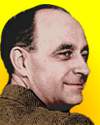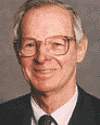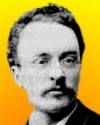
On 29 Sep 1859, Hermann Biggs was born, the American physician who was New York City's Public Health Officer and pioneered the use of bacteriological studies in the field of public health for the prevention and control of contagious diseases.
Today, vaccinating a baby is routine to prevent a number of diseases, including diphtheria, polio and tetanus, because these can cause death. It was not always so. First a suitable vaccine had to be developed and manufactured. Then the population had to become involved in an broad immunization effort. For each of these, there needed to be pioneers. One such pioneer was Hermann Biggs, who more than a century ago, took on the task of improving the collective public health in New York City.
In The New Treatment of Diptheria, from The Century Magazine (Jan 1895), Biggs communicated to the general reader that “The new anti-toxine treatment of diphtheria promises to prove one of the most important developments of modern medicine.” In this article, you can read in his own words, how diphtheria antitoxin was being produced in the U.S. by the New York City Board of Health. In these early days of bacteriology, imagine how the magazine's readers may have reacted to such news, because they knew the deadly effects of diptheria as it occurred then. Then consider how the world has benefitted since then, and how routine such vaccinations have become.

On 29 Sep 1901, Enrico Fermi was born, one of the chief architects of the nuclear age. Today's book pick is: , by , who knew Fermi as a friend, having been his student, then his collaborator. Both became Nobel Prize winners. This well-researched biography of this brilliant master of physics and mathematics, presents a rich, well-rounded portrait of Fermi the scientist, his methods, intellectual history, and achievements. Fermi's classic experiments on artificial radioactivity eventually yielded the atomic pile, the first controlled nuclear power. As one of Time magazine's top 20 scientists, Fermi's work should be high on your reading list.
It is available from Amazon, typically about (As of earlier time of writing - subject to change.)
 | Public health is purchasable. Within a few natural and important limitations any community can determine its own health. |
 | The human body is the only machine in which there are no spare parts. |
 | Young man, if I could remember the names of these particles, I would have been a botanist. |
 | Some men said the atomic bomb should never have been built; researchers should have stopped working when they had realized that the bomb was feasible. Enrico did not think this would have been a sensible solution. It is no good trying to stop knowledge from going forward. Whatever Nature has in store for mankind, unpleasant as it may be, men must accept, for ignorance is never better than knowledge. Note: Although attributed as his viewpoint to Enrico Fermi, it is probably not a direct quote by him. |
| Before you look at today's web page, see if you can answer some of these questions about the events that happened on this day. Some of the names are very familiar. Others will likely stump you. Tickle your curiosity with these questions, then check your answers on today's web page. | |
| Births | |
 | Paul MacCready, born 29 Sep 1925, is an American aerodynamicist who headed a team that designed and built both the first man-powered aircraft and the first solar-powered aircraft capable of sustained flights. On 23 Aug 1977, the man-powered aircraft successfully demonstrated sustained, maneuverable manpowered flight. Can you name this man-powered aircraft? |
 | Enrico Fermi, physicist, born 29 Sep 1901 was one of the chief architects of the nuclear age. Working in America, he discovered neutron-induced radioactivity, and directed the first controlled chain reaction involving nuclear fission. What was Fermi's nationality at the outbreak of World War II? |
| Deaths | |
 | Rudolf Diesel (1858-1913) was a German thermal engineer who was also a distinguished connoisseur of the arts, a linguist, and a social theorist. For what invention is he best known? |
| no image | Friedrich Mohs (1773-1839) was a German mineralogist who devised a scale to compare mineral hardness, based on ten common or readily available minerals. Which minerals did Mohr select for the the least hard (1) and the most hard (10)? |
| Events | |
 | On 29 Sep 1891, a U.S. patent was issued to an inventor for a "Process of and Apparatus for Generating Electricity" and on 29 Sep 1914, a patent for a "Phonograph-Record" was granted to the same man. Who was this inventor? |
 | On 29 Sep 1954, with ratifications complete, an organization was founded to provide first class facilities to coordinate fundamental research in particle physics. What is this organization, and where is it located? |
Fast answers for the previous newsletter for September 28: Seymour R. Cray • fluorine • he provided the first evidence of the expansion of the universe • his method of killing harmful bacteria in a liquid (such as milk) by holding it for a suitable time at a given temperature • amino acids • platinum-iridium.
 If you enjoy this newsletter, the website, or wish to offer encouragement or ideas, please send feedback by using your mail reader Reply button.
If you enjoy this newsletter, the website, or wish to offer encouragement or ideas, please send feedback by using your mail reader Reply button. Your click on a Facebook, StumbleUpon, or other social button on the site webpages is also a welcome sign of appreciation. Thank you for using them.
© This newsletter is copyright 2020 by todayinsci.com. Please respect the Webmaster's wishes and do not put copies online of the Newsletter — or any Today in Science History webpage. (If you already have done so, please remove them. Thank you.) Offline use in education is encouraged such as a printout on a bulletin board, or projected for classroom viewing. Online, descriptive links to our pages are welcomed, as these will provide a reader with the most recent revisions, additions and/or corrections of a webpage. For any other copyright questions, please contact the Webmaster by using your mail reader Reply button.
--
If you do not want to receive any more newsletters, Unsubscribe
To update your preferences and to unsubscribe visit this link
Executive Real Estate Business Class
-
"It was like a man with wings. It wasn't like anything you'd see on TV or in a monster movie." ...
About the publisher
Search This Blog
Blog Archive
-
▼
2020
(1542)
-
▼
September
(173)
- SCIENCE: Just how big is Everest?
- The Latest News from History News Network
- On This Day for September 30 - Munich Agreement si...
- We are called to return to our foundational values...
- Newsletter for Wednesday 30 September.
- They Killed His Wife And Left Him For Dead – Then ...
- TRAVEL: Telling new truths about America’s histori...
- Make learning fun with Nat Geo Kids magazine! Subs...
- On This Day for September 29 - British mandate in ...
- Newsletter for Tuesday 29 September.
- Special Edition: Dinosaurs come to life like never...
- September 29: On This Day in History
- HISTORY: America's most endangered historic sites
- New This Week on History News Network
- On This Day for September 28 - California “discove...
- Newsletter for Monday 28 September.
- September 28: On This Day in History
- FAMILY: What do I tell my kids about wildfires and...
- On This Day for September 27 - Norman Conquest beg...
- Newsletter for Sunday 27 September.
- September 27: The Rosetta Stone, E=mc² and Fear as...
- The Compass: Indonesia
- On This Day for September 26 - First televised U.S...
- Newsletter for Saturday 26 September.
- September 26: Frances Drake's Circumnavigation, th...
- CORONAVIRUS UPDATE: Is this the end of the office?
- PHOTOGRAPHY: They feed us. Now we see them.
- The assassination of Lord Mountbatten | Enola Holm...
- 39,500-Year-Old Cave Bear Discovered Perfectly Pre...
- On This Day for September 25 - Pacific Ocean sight...
- The Roundup Top Ten for September 25, 2020
- Newsletter for Friday 25 September.
- September 25: Battle of Stamford Bridge, Remote Co...
- ANIMALS: These mighty elephants find peace
- On This Day for September 24 - Federal troops sent...
- Newsletter for Thursday 24 September.
- Global cartels taking control of the world + HPA B...
- September 24: Decline of the Byzantine Empire, Ope...
- YOUR WEEKLY ESCAPE: America's oldest mystery
- SCIENCE: How to cope with a big death toll
- The Latest News from History News Network
- On This Day for September 23 - Neptune observed, J...
- Newsletter for Wednesday 23 September.
- September 23: Nintendo, the Start of Data Processi...
- TRAVEL: How will America’s state parks survive?
- Matching gift opportunity for Sumatran rhinos
- On This Day for September 22 - Solidarity formed, ...
- Newsletter for Tuesday 22 September.
- September 22: Salem Witch Trials, Iraq's Invasion ...
- HISTORY: Who can replace RBG?
- Feed their curiosity! Get Nat Geo Kids magazine fo...
- New This Week on History News Network
- On This Day for September 21 - Joseph Smith's visi...
- Newsletter for Monday 21 September.
- September 21: France, China and a Sheep Shearing R...
- FAMILY: Don’t tell your kids outdated stuff about ...
- On This Day for September 20 - Rome incorporated i...
- Pro-life is not Politics + Vickie Travis's message...
- Newsletter for Sunday 20 September.
- September 20: Attila the Hun, Magellan's Circumnav...
- The Compass: Chile
- Matching gift opportunity for Sumatran rhinos
- On This Day for September 19 - George Washington's...
- Newsletter for Saturday 19 September.
- CORONAVIRUS UPDATE: Young people are spreading the...
- September 19: 1st Country to Grant Women the Right...
- PHOTOGRAPHY: How to make dinos look new (CORRECTED)
- Quick Note: How to Save Videos by Downloading
- PHOTOGRAPHY: How to make dinos look new
- The Mayflower | Medieval spiders | Ancient Egypt f...
- When She Found Out Her Boyfriend Was A Serial Kill...
- The Roundup Top Ten from History News Network
- On This Day for September 18 - Mukden seized by Ja...
- Newsletter for Friday 18 September.
- "Truth Crushes Evil" + We're Winding down + What ...
- YOUR WEEKLY ESCAPE: The country that doesn't exist
- September 18: Great Fire of Moscow, the CIA and El...
- ANIMALS: How U.S. officials stopped the flying squ...
- Two New Podcasts From HISTORY
- Don't miss out: back to school savings for learner...
- On This Day for September 17 - Camp David Accords ...
- Newsletter for Thursday 17 September.
- September 17: Bloodiest Day in the American Civil ...
- SCIENCE: He found part of a one-of-a-kind dinosaur
- SPECIAL REPORT: How the West is primed to burn
- The Latest News from History News Network
- On This Day for September 16 - Mayflower's departu...
- Newsletter for Wednesday 16 September.
- September 16: French Abolish Slavery, Malaysia For...
- TRAVEL: Will slowing down help you get stronger?
- Special Report: How do we end this pandemic?
- On This Day for September 15 - Central Americans g...
- Newsletter for Tuesday 15 September.
- September 15: Darwin Reaches the Galapagos, Penici...
- HISTORY: How the U.S. battled catastrophic wildfir...
- BREAKING NEWS: Possible evidence of life found on ...
- Discover Remarkable Leaders With Nat Geo History M...
- On This Day for September 14 - Mexico City capture...
- New This Week on History News Network
- Newsletter for Monday 14 September.
-
▼
September
(173)
-
Blogroll
-
About
HistoryFact










0 comments:
Post a Comment